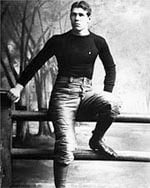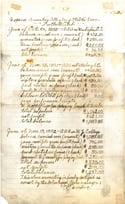The date was November 12, 1892, a day that would forever be etched in sports history, although no one involved that day could possibly have recognized the importance of the occasion. It was the day that the Allegheny Athletic Association football team defeated the Pittsburgh Athletic Club. The game in itself was not a momentous event. But one of the circumstances of the game did make it a never-to-be-forgotten moment in sports history – one of the AAA players, William (Pudge) Heffelfinger, was openly paid $500 to play the game. Thus pro football made its debut more than 100 years ago in comparatively obscure surroundings that could not possibly have provided the slightest clue to the world-wide popularity the sport would be destined to enjoy, particularly in the waning decades of pro football's first century.
 While the PAC had suspected something illegal was afoot, there was no immediate evidence to back up its belief that the AAA had abandoned the standard practices of the day by actually paying someone to play football. Absolute verification, in fact, did not become public for almost 80 years until the Pro Football Hall of Fame received and displayed a document – an expense accounting sheet of the Allegheny Athletic Association that clearly shows a "game performance bonus to W. Heffelfinger for playing (cash) $500. While it is possible that others were paid to play before 1892, the AAA expense sheet provides the first irrefutable evidence of an out-and-out cash payment. It is appropriately referred to today as "pro football's birth certificate."
While the PAC had suspected something illegal was afoot, there was no immediate evidence to back up its belief that the AAA had abandoned the standard practices of the day by actually paying someone to play football. Absolute verification, in fact, did not become public for almost 80 years until the Pro Football Hall of Fame received and displayed a document – an expense accounting sheet of the Allegheny Athletic Association that clearly shows a "game performance bonus to W. Heffelfinger for playing (cash) $500. While it is possible that others were paid to play before 1892, the AAA expense sheet provides the first irrefutable evidence of an out-and-out cash payment. It is appropriately referred to today as "pro football's birth certificate."
The sport of American football itself was relatively new in 1892. Its roots stemmed from two sports, soccer and rugby, which had enjoyed long-time popularity in many nations of the world. On November 6, 1869, Rutgers and Princeton played what was billed as the first college football game. However, it wasn't until the 1880s that a great rugby player from Yale, Walter Camp, pioneered rules changes that slowly transformed rugby into the new game of American Football.

Meanwhile, athletic clubs that sponsored a great variety of sports teams became a popular phenomenon in the United States in the years immediately after the Civil War. One of the sports the athletic club embraced was football.
By the 1880s, most athletic clubs had a football team. Competition was heated and each club vowed to stock its teams with the best players available. Toward this end, some clubs obtained jobs for star players. Others "awarded" expensive trophies or watches to their players, who would in turn pawn their awards, only to receive them again and again after each game they played. A popular practice was to offer double expense money to players for their services. Since football players were supposed to be amateurs, these practices were questioned by the Amateur Athletic Union but for every tactic declared illegal, a new one was developed.
Thus the scene was set for the AAA-PAC showdown. The actions before, during and after the game are as intriguing as the fact that someone was openly paid to play football for the first time. The Allegheny football team, founded in 1890, and the Pittsburgh team, founded a year later, already were heated rivals when they met in the first of two games in the 1892 season and wound up in a 6-6 tie. Adding fuel to the fire was the AAA claim that the PAC's top player and coach, William Kirschner, was a professional because, as a paid instructor for the PAC, his salary went up and his work load down during the football season. With controversy raging, both sides began to explore methods of beefing up their squads.
For years, Brallier was considered to be first pro
Early-day pro football historians agreed that a 16-year-old quarterback from Indiana College in Pennsylvania, John Brallier, had become the first pro football player when he accepted $10 and "cakes" (expenses) to play for the Latrobe, PA, town team against neighboring Jeannette on September 3, 1895.
After the Pro Football Hall of Fame was opened in 1963 in Canton, further research uncovered the Pudge Heffelfinger payment by the Allegheny Athletic Association in 1892 and thus negated the Latrobe claim as the birthplace of pro football.
Today, Brallier is ranked no higher than seventh in line among the early-day players accepting pay to play.
Listed below are the first seven players known to have been openly paid to play football:
William "Pudge" Heffelfinger – Allegheny Athletic Association, Pittsburgh, – $500 for one game on November 12, 1892.
Ben "Sport" Donnelly – Allegheny Athletic Assocation, Pittsburgh – $250 for one game on November 19, 1892.
Peter Wright – Allegheny Athletic Association, Pittsburgh – $50 per game (under contract) for the entire 1893 season.
James Van Cleve – Allegheny Athletic Association, Pittsburgh – $50 per game (under contract) for the entire 1893 season.
Oliver W. Rafferty – Allegheny Athletic Association, Pittsburgh – $50 per game (under contract) for the entire 1893 season.
Lawson Fiscus – Greenburg, PA – $20 per game (under contract) for the entire 1894 season.
John Brallier – Latrobe, PA, – $10 and expenses for one game on September 3, 1895.
The AAA and PAC both focused their attention on the strong Chicago Athletic Association team that utilized the "double expense money" ploy to keep its players happy. Heffelfinger, who had been a three-time Yale All-America guard in 1889, 1890 and 1891, had been granted a leave of absence from his job as a low-salaried railroad office employee in Omaha so he could accompany the Chicago team on a six-game tour of the East.
The PAC, with a particular sense of urgency after its star Kirschner had been sidelined with an injury, scouted Chicago in a tour-opener against the Cleveland Athletic Association. Chicago won easily and Heffelfinger had an outstanding game. The Pittsburgh Press on October 30, 1892 reported that Heffelfinger and Knowlton "Snake" Ames of the Chicago team had been offered $250 to play for the PAC against the Allegheny Athletic Association in the upcoming November 12 game.
Thus alerted, the AAA did some scouting of its own and found that Ben "Sport" Donnelly, a star end, and Ed Malley would play with the AAA for the usual "double expense money." Ames was unwilling to risk his amateur standing for any price and Heffelfinger said only he couldn't risk his amateur status for a mere $250. In effect, pro football had its first "holdout" even before it had its first pro. When the AAA representatives learned that Heffelfinger would play for $500, they readily welcomed him into the fold.
When the teams took the field on November 12, PAC players quickly noticed that Heffelfinger, Donnelly and Malley were in AAA uniforms. The PAC coach took his team off the field because, among several reasons, followers of both sides had bet heavily on the game and the AAA obviously had tilted the scale with ringers. Finally, it was agreed that game would be played as an exhibition and that all bets would be off.
The lengthy bickering had delayed the kickoff so long that the game had to be shortened to two 30-minute halves (instead of 45 minutes) to beat the autumn darkness soon to descend on Pittsburgh. Midway through the first half, Heffelfinger scored the game's only touchdown when he forced a fumble, recovered it, and raced 25 yards for a score. Touchdowns counted four points in 1892, so Allegheny won 4-0.
Almost no one was happy with the result. AAA fans were angry because they were unable to collect on their bets. PAC followers were furious over the use of the Chicago players and charged that Heffelfinger had actually been paid cash to play. The AAA manager O.D. Thompson insisted he had acted prudently and had merely done "what the Pittsburghs tried to do. Only we were successful where they failed." It should be noted that the expense accounting sheet that years later proved the PAC charges to be correct was signed by none other than O.D. Thompson.
That now-famous Allegheny Athletic Association expense sheet also showed that the AAA realized a net profit of $621 for the game, despite the "huge" payment to Heffelfinger. Since winning and maintaining financial solvency were dual objectives in 1892 just as they are today, the AAA's first venture into pro football had proved satisfactory, both on and off the field.